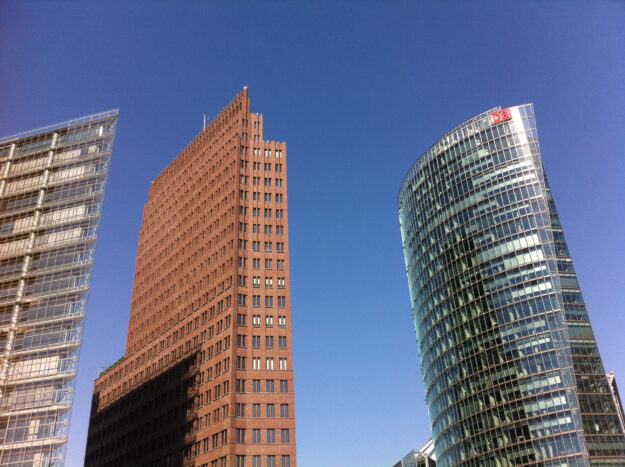I wasn’t sure if I should actually file the Potsdamer Platz under ‘tourist sights’ and ‘sightseeing’ – or if it should rather belong in the ‘discover’ section, where I list streets and places. But since Potsdamer Platz is so much more than just an address, I would actually consider it a full blown tourist attraction.
First thing I think one should know about Potsdamer Platz is of course its history. Before the Second World War, the Potsdamer Platz was one of the busiest traffic intersections in Europe – if not the busiest. In the twenties, one of the first traffic lights and actually the first electrical traffic light of Europe was erected on Potsdamer Platz.
In the eighties on the West-Side a test track for a magnetic monorail train was built. Besides the tracks for the monorail there were a couple of fast food stands, a ‘circled wagon train’ and some viewing platforms with a view to the East.
And in the late 70ies, early 80ies plans to build an Autobahn parallel to the Berlin Wall were developed. These plans were dropped only after the Fall of the Wall. Parts of the movie ‘Himmel über Berlin’ are set the hopelessness of these ‘wastelands’ of the 80ies at Potsdamer Platz.
Today nothing of this hopelessness or the ‘wastelands’ is left – but you can actually see some original pieces of the Wall near S-Bahn station Potsdamer Platz / Ebertstrasse.
The Potsdamer Platz consists of two – maybe three major areas. First, on the Tiergarten-Side Potsdamer Strasse: the Sony Center with its iconic Mount-Fuji-insipred glass roof and the glass tower aka Bahn Tower. Second: the buildings on the opposite side of Potsdamer Strasse, including the theater at Marlene Dietrich Platz, the Shopping Mall “Potsdamer Platz Arkaden”, a collection of buildings designed by various world famous architect and the historical building ‘Haus Huth’ as well as the Kollhoff-Tower. And third: the buildings called ‘Beisheim Center’ next to the Sony Center.
Sony Center
The Sony Center is a landmark. Probably the most impressive details of the trangle shaped complex is the tent-like roof, inspired by Japan’s Mount Fuji, covering a round square. Around that square a number of cafés and restaurants are located – but also the movie theaters CineStar and IMAX and other film institutions are located here: The Deutsche Kinemathek – Museum für Film und Fernsehen (German Film and TV Museum), the Filmhaus, the Deutsche Film- und Fernsehakademie Berlin dffb (the German Film and Television Academy Berlin) and another movie theater specialized on historical films Arsenal are located all in Sony Center.
Beisheim Center / Hotel Ritz-Carlton Berlin / Hotel Berlin Marriott
The Beisheim Center is a group of buildings, built by German-Swiss businessman (and founder of Metro AG) Otto Beisheim. The Beisheim Center is located on the so called Lenné-Triangle.
To me the buildings of Beisheim Center look like a group of ‘cut-off top floors’ of American-style skyscrapers – or as if skyscrapers were bug into the ground and only the top floors were sticking out. But I guess that was originally intended by the architect.
On the grounds of Beisheim Center two 5-star hotels can be found: the Ritz-Carlton Berlin and the Berlin Marriott. During the International Berlin Film Festival Berlinale film stars like to stay in one of the two hotels since they are located so close to the main festival grounds.
Nineteen buildings, ten streets, two public squares – that’s the Quartier Potsdamer Platz right opposite of Sony Center, across the ‘Boulevard of Stars’.
The 550.000 square meters area features two hotels, a cinema, three theaters, a casino, the shopping mall Potsdamer Platz Arkaden with more than 130 shops and around 30 restaurants, bars and cafés, offices and of course both rental apartments and condominiums.
Once a year Marlene-Dietrich-Platz is covered in red and a giant disco ball is hanging from the ceiling of the theater at Marlene-Dietrich-Platz 1. This is basically the headquarter of the International Berlin Film Festival Berlinale – this is where the big pictures are shown and where the stars walk the carpet.
When you are visiting Potsdamer Platz, you should have a look at this area’s architecture. The buildings were all designed and realized by a group of world class architects, offices and planning authorities:
- Renzo Piano / Christoph Kohlbecker Genoa/Gaggenau
- Arata Isozaki, Tokyo
- Prof. Hans Kollhoff, Berlin
- Ulrike Lauber & Wolfgang Wöhr, Munich
- José Rafael Moneo, Madrid
- Richard Rogers, London
You can either experience the architecture directly by roaming through the streets between the different buildings, or have look at the buildings from a distance. The park right next to Quartier Potsdamer Platz provides a great view on the facades – and you can also sit on the lawn of Tilla-Durieux-Park.
Observation Deck at Kollhoff-Tower
At 24th and 25 floor of the brick covered Kollhoff-Tower, Potsdamer Platz 1, you’ll find the observation deck “Panoramapunkt”. For further information see also the page about Berlin Observation Decks and Platforms.
How to get here / public transport:
- U-Bahn: take the U-Bahn U2 to S+U station Potsdamer Platz.
- S-Bahn: take the S-Bahn S1, S2 or S25 to S+U station Potsdamer Platz.
- Buses: take bus 200, M41, M48, M85 or N2 and get off either at bus stop Varian-Fry-Strasse, at Abgeordnetenhaus, at Kulturforum, at Philharmonie or directly at S+U Potsdamer Platz [Bus Stresemannstr.]
- Regional Train: take RB19, RE3, RE4 or RE5 and get off at S+U Potsdamer Platz Bhf
See also:
Homepage of Quartier Potsdamer Platz: www.potsdamerplatz.de/en
Nearby Things to See / Things to Do / Sights:
- Brandenburger Tor
- Kulturforum
- Memorial to the Murdered Jews of Europe / Holocaust Memorial
- Reichstag
- Staatsbibliothek
- Tiergarten
Do you have and thoughts, suggestions, additional recommendations or comments? Please feel free to leave your comment below. Thank you!

